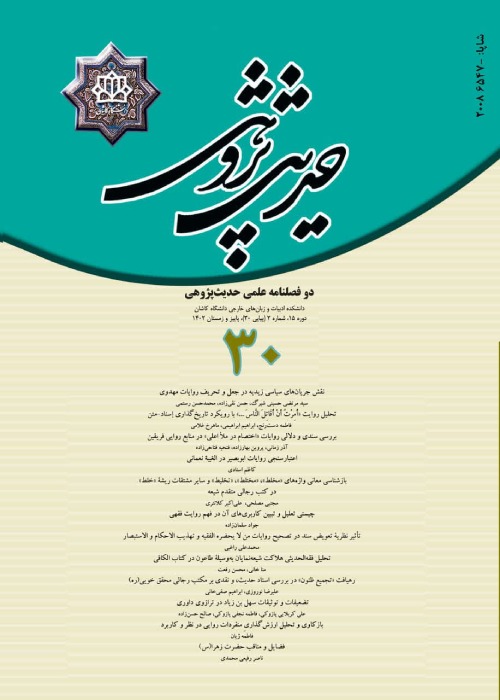An Analysis of the Ḥadīth “umirtu an uqātila al-nās" (I have been commanded to fight people…) Using an Isnād-Text Dating Approach
Throughout the history of Islam, incorrect and biased readings of some Qurʾānic ayahs and Aḥādīth have always caused doubts and objections to the sanctity of this religion. Considering that among the decrees covered by the Qurʾān and Aḥādīth is Jihad and the issues surrounding it, and the Ḥadīth “umirtu an uqātila al-nās" (I have been commanded to fight people) is one of the challenging Aḥādīth in this field cited in the jurisprudential rulings of Jihad, with incorrect readings of this Ḥadīth and reference to it, some intend to present Islam as a violent religion. Therefore, an analysis of this Ḥadīth using new research methods and approaches can provide a methodical reading of it.
Since the dating of Aḥādīth determines the approximate time of their emergence as well as the course of their historical development, the present article seeks to analyze the aforementioned Ḥadīth using an analytical and combined dating method. To do so, first, the course of historical development of the Ḥadīth at issue will be determined using external and internal dating and then external data and contexts will be employed to externally date the Ḥadīth. Afterwards, given the various writings of such Aḥādīth in Ḥadīth and fiqh sources of Sunnah and Shia, the important points in its internal dating will be investigated. The next step is finding a "common circle" which in the review of the documents of the Ḥadīth will help to determine its date. The final result will arise from the integration and comparison of these reviews that will be presented in the form of isnād-text combined analysis. It is necessary to mention that one of the problems in the external dating of Aḥādīth is studying the cause of entry or the circumstances of the issuing of the Ḥadīth. Accordingly, in external dating of the Aḥādīth expressing the circumstances of issuing of the Ḥadīth “I have been commanded to fight against the people until they testify that there is none worthy of worship except Allah. If they do that, their lives and their properties are protected from me, except for the rights of Islam.” it is particularly important to find the historical course of the sources under discussion as well as the historical references mentioned in the Ḥadīth. In the dating of the text of the Ḥadīth, the first step is finding and studying commonalities and differences between different writings of the Ḥadīth in order to achieve the possible and probable developments in the text that can show the overall picture of the changes made in the Ḥadīth. In fact, the structures added to the text or reduced from it, help to attain the original structure of the narrative which other writings of the Ḥadīth have most probably originated from it.
Results and Finings:
The dating of the Ḥadīth "umirtu an uqātila al-nās" (I have been commanded to fight people…) showed that this Ḥadīth includes the highest variety of tradition in Sunni narrative sources, particularly in their primary sources, and the texts of these Aḥādīth differ from each other in terms of phrasings and wordings to the extent that one can say these differences are not merely structural. The common circles of these Aḥādīth among the Sunni sources are Abu Hurayra, Malik ibn Anas, Nu'man ibn Salim, and Aws ibn Abi Awas. The oldest source of this Ḥadīth is a fiqh reference among Sunnis and the history of its fiqhi application goes back to the conversation between Umar and Abu Bakr during Ridda Wars, in which citing from the Prophet (S) in the aforesaid Ḥadīth, the decree of fighting those refusing to give Zakat has been drawn while in the cause of the entry of this Ḥadīth which has happened at the time of Wafd Thaqeef, we see an opposing viewpoint. In fact, it can be understood from these Aḥādīth that the Prophet (S) aimed at preventing and specifying the limit of fight and the Aḥādīth concern this limit rather than the cause of fight, that is, La Ilaha Illallah is the redline of fight. Therefore, if the fighting side says La Ilaha Illallah, fighting against them becomes unjustifiable. The network of isnād of the Aḥādīth that in addition to La Ilaha Illallah includes other propositions has ways of singular tradition and the common ring of these Aḥādīth is Qutaiba ibn Said, the closest transmitter to the collectors of Ḥadīth.
The network of isnāds in this group of Aḥādīth, has a spider-like web, which indicates the weakness of the Ḥadīth in question. The Ḥadīth “umirtu an uqātila al-nās" (I have been commanded to fight people) has a singular tradition and it has not been included in the primary sources of Shia although Sheikh Sadugh and Sheikh Tousi, living in the fourth and fifth (AH) centuries, have narrated this Ḥadīth with Sheikh Sadough citing a reference for his mention. Also, naming its source, Barghi has mentioned this Ḥadīth in his Al Mahasen. Because of ways of singular tradition as well as being narrated with no name of the transmitter in other sources, however, drawing the network of isnād and finding the common ring in Shia sources for this Ḥadīth is impossible.
- حق عضویت دریافتی صرف حمایت از نشریات عضو و نگهداری، تکمیل و توسعه مگیران میشود.
- پرداخت حق اشتراک و دانلود مقالات اجازه بازنشر آن در سایر رسانههای چاپی و دیجیتال را به کاربر نمیدهد.



